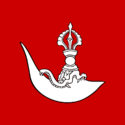Great Nam
Great Nam | |||||||||||||
|---|---|---|---|---|---|---|---|---|---|---|---|---|---|
| 963–1377 | |||||||||||||
|
Flag | |||||||||||||
| Capital | Tang Shong | ||||||||||||
| Government | Monarchy | ||||||||||||
| Seinam | |||||||||||||
• 963-968 | Chodron I (first) | ||||||||||||
• 1377 | Rigzin (last) | ||||||||||||
| Legislature | Kashag | ||||||||||||
| Historical era | Medieval | ||||||||||||
• Established | 963 | ||||||||||||
• Vassalage to Jiao Dynasty | 1377 | ||||||||||||
| |||||||||||||
| Today part of | |||||||||||||
| |||||||||||||
The Great Nam (Namkha: ནམྱུ་ཆེན་པོ Nam chen po) was an empire which ruled in Southern Coius and Satria during the medieval period. It emerged out of the remains of the Drukarma dynasty in the Lhochum valley, going on to span across all of modern day Duran as well as swathes of Satria and Ansan. The Great Nam period is seen as a high point of Duranian culture and influence, with the foundations of modern Duran's culture and demographics being laid during this period. However, its legacy is more controversial in Satria due to the Lak Pa Trel, a system of human tithing which resulted in economic damage to the peripheries of the state.
The Great Nam arose during a period of interregnum which occured following the death of Gyurmey IV, in which the vassal state of Tang Shong emerged as the dominant force. It was aided by an alliance with several important Gyadrul warlords, providing the state with access to strong armies. Having unified the Lhochum valley and with nominal hegemony over the existing Gyadrul petty kingdoms, the Nam state began expanding outward across the plains of Satria. A valley state dependent on rice paddy agriculture, the Great Nam instituted major social structural reforms under the blueprint of Sengshui in order to better regulate the movement of people and services and centre power upon a Nampa Zohist elite. Most controversial of this was the Lak Pa Trel, whereby villages were required to provide workers to the core of the empire for agricultural work, military work, and other central roles.
However, as the Great Nam state expanded, it came under increasing pressure due to its authoritarian and centralised ruling structure. Later Gyadrul migrations placed pressure on the administration's core, while an increasingly decadent bureaucracy was unable to handle the task of holding the empire together. As local areas began breaking away and developing local identities, Nam came under the influence of a resurgent Shangea and Ansan which both exerted influence. Despite losing the vast bulk of its territories by the 1300s and becoming a vassal of a series of neighbouring powers, the Nam state would remain remarkably stable in and of itself and this rump state would become the modern Duran.
